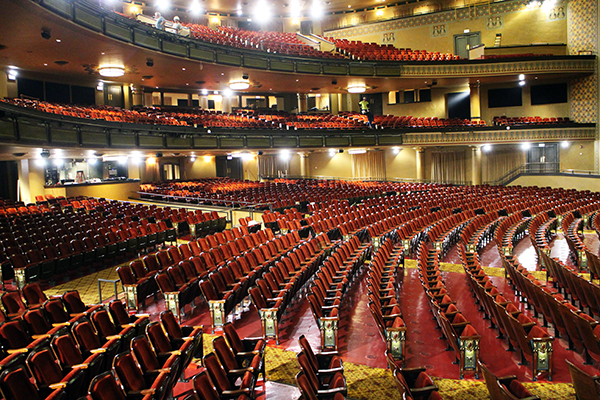
The renovated Altria Theater officially reopened over the weekend after a multimillion dollar upgrade project. Photo by Kate Demeria.
After two and a half years of renovations, the Altria Theater, formerly known as the Landmark and the Mosque, reopened on Sunday.
Only a few finishing touches remain before the $63 million renovation project is complete, said Jay Smith, a partner with public affairs firm Capital Results speaking on behalf of the theater.
“We tried to keep the character of a 1920s theater, including its Moroccan theme, but also then include the amenities that people have come to expect of a 20th-century theater,” Smith said.
Multiple sources provided funding for the project. The city of Richmond, which owns the theater property, contributed $14 million. Another $31 million came through historic tax credit financing and $18 million is being raised through private donations. The theater is operated by the CenterStage Foundation.
Originally only $15 million in private donations was sought for the renovations, but Smith said the project scale changed, with new additions to the ballroom beneath the theater pushing the cost up to $63 million.
The Landmark and Legacies Capital and Endowment Campaign has been responsible for raising the funds. It is about $2.2 million short of reaching its $18 million private donations goal. It will then focus its efforts on raising an additional $10 million toward a private endowment.
The theater took on the Altria name earlier this year after a $10 million commitment from the Richmond tobacco giant.
Other larger donations to the project include $2 million from Dominion Resources, $1 million from local businessman and philanthropist Bill Gottwald and his Herndon Foundation, and $500,000 from the Mary Morton Parsons Foundation.
More than a third of the funds went to infrastructure, Smith said, including roof repairs, the exterior facade and mechanical systems.
Gilbane Christman was the general contractor for the renovation, and Bruce Herrmann of Boston-based Wilson Butler Architects was lead architect. He and his team were able to restore many of the original details to the theater’s interior decorations, including columns and murals.
The building is around 180,000 square feet and now includes several concession bars and lounges throughout its five levels, as well as two more elevators. The theater contains more than 3,600 renovated seats.
And just as the dust settles at the theater, the organization has plans for construction of a new cafe at Main and Laurel streets, Smith said. That project is still in its preliminary planning stages, and work should begin in January.
[soliloquy id=”66918″]

The renovated Altria Theater officially reopened over the weekend after a multimillion dollar upgrade project. Photo by Kate Demeria.
After two and a half years of renovations, the Altria Theater, formerly known as the Landmark and the Mosque, reopened on Sunday.
Only a few finishing touches remain before the $63 million renovation project is complete, said Jay Smith, a partner with public affairs firm Capital Results speaking on behalf of the theater.
“We tried to keep the character of a 1920s theater, including its Moroccan theme, but also then include the amenities that people have come to expect of a 20th-century theater,” Smith said.
Multiple sources provided funding for the project. The city of Richmond, which owns the theater property, contributed $14 million. Another $31 million came through historic tax credit financing and $18 million is being raised through private donations. The theater is operated by the CenterStage Foundation.
Originally only $15 million in private donations was sought for the renovations, but Smith said the project scale changed, with new additions to the ballroom beneath the theater pushing the cost up to $63 million.
The Landmark and Legacies Capital and Endowment Campaign has been responsible for raising the funds. It is about $2.2 million short of reaching its $18 million private donations goal. It will then focus its efforts on raising an additional $10 million toward a private endowment.
The theater took on the Altria name earlier this year after a $10 million commitment from the Richmond tobacco giant.
Other larger donations to the project include $2 million from Dominion Resources, $1 million from local businessman and philanthropist Bill Gottwald and his Herndon Foundation, and $500,000 from the Mary Morton Parsons Foundation.
More than a third of the funds went to infrastructure, Smith said, including roof repairs, the exterior facade and mechanical systems.
Gilbane Christman was the general contractor for the renovation, and Bruce Herrmann of Boston-based Wilson Butler Architects was lead architect. He and his team were able to restore many of the original details to the theater’s interior decorations, including columns and murals.
The building is around 180,000 square feet and now includes several concession bars and lounges throughout its five levels, as well as two more elevators. The theater contains more than 3,600 renovated seats.
And just as the dust settles at the theater, the organization has plans for construction of a new cafe at Main and Laurel streets, Smith said. That project is still in its preliminary planning stages, and work should begin in January.
[soliloquy id=”66918″]